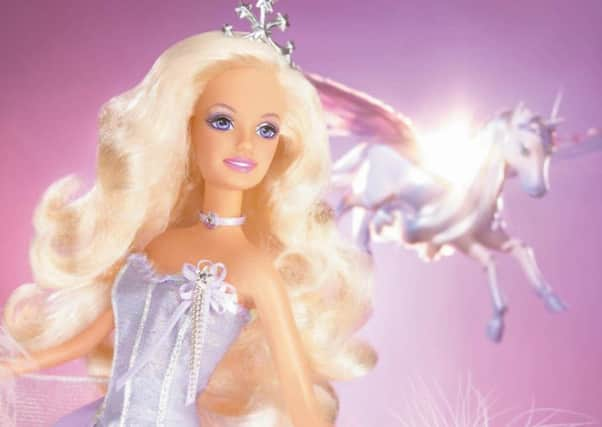Disabled Barbie dolls: the acceptable face of corporate cynicism? – Martyn McLaughlin


I arrived home the other night to find my eldest daughter busying herself in her playroom with a clutch of coloured pencils. She had found the memory book we gave her after my father’s death last year and was scribbling away contently.
In those first painful few weeks after his passing, the journal was a conduit for her grief. Blu-Tacked photographs, stick figures, and hearts vied for space on every other page. Sometimes, there were just agitated scribbles. I knew what she meant.
Advertisement
Hide AdAdvertisement
Hide AdCome the turn of the year, the sharpest edges of her loss had been blunted, and the entries to the journal became less frequent. We would still look together through the pictures, accepting and remembering, though the blank pages went unfilled.
Out of nowhere, the latest drawing presented a new chapter. It captured a happy time, mere weeks before his death, when we all went on a family holiday. It was a difficult trip, but a worthwhile one, designed to say goodbye and form lifelong memories. I will never forget seeing it rendered anew by my four-year-old’s hand.
But one detail took me by surprise. While the rest of us were depicted running through leafy trails, she drew my father racing ahead in his wheelchair, arms raised and a broad smile on his face.
He had only been immobile for the last two months of his life, and just like his illness, it did not define him. Yet it was a part of him, and I realised, part of my daughter’s defining impressions of him.
Since then, the issue of disability has nudged aside mermaids as her obsession of the moment. She comments excitedly on seeing disabled presenters and children on television, and has even taken to collecting the proceeds of a makeshift sweet shop in her bedroom for charity. Happily, this means I can look forward to a chocolate football after evening meals.
But in trying to encourage her interest further, I found it difficult to gauge my next step. There is a host of sensory and switch-operated toys designed for children with disabilities, but where are the toys which simply represent the wider disabled population?
Looking online, I discovered other parents searching for a similar answer. There is no shortage of books which help disabled children see themselves – and their loved ones – as they are, but what of the playthings? Something tangible to hold and to hug?
One Google search later, I realised it was not only parents asking such questions, but the world’s leading toy manufacturer. It turns out Mattel is to release a new range of Barbie dolls, complete with a wheelchair and prosthetic limbs. The move, it says, will help “elevate the conversation around physical disabilities”.
Advertisement
Hide AdAdvertisement
Hide AdIt may be because of my longstanding refusal to submit to the tyranny of pink which confronts my daughters in every toy shop, but I found it hard to get too excited.
It is, of course, welcome that the toy industry holds up a mirror to less able children, and the announcement has been understandably praised by campaigners. But perhaps it would be prudent to question whether Mattel is truly committed to diversity, or is simply trying to commodify it.
This is, after all, not the first time it has introduced a disabled figurine. In 1997, it released Share a Smile Becky, a friend of Barbie’s, who came with a pink wheelchair. Thousands of dolls were sold in the first few weeks, until Kiersti Johnston, a teenager with cerebral palsy, pointed out Becky was unable to fit inside Barbie’s Dream House. Mattel made a few tweaks, but before long, Becky quietly disappeared from shop shelves.
Why has it taken Mattel more than two decades to put that right? The answer may lie in its accounts, which offer a stark alternative to the glossy, plastic world it curates.
Since 2014, its UK subsidiary has accrued losses of £9.3m. Its parent company, Mattel Inc, has also endured a turbulent time of late, posting an operating loss of £262m in 2017. The firm has been at pains to point to the collapse of Toys R Us and a one-off £349m charge related to new US tax legislation. Both are valid explanations. But they are not excuses.
Until recently, Mattel’s executives referred to Barbie as a “challenged brand”, which in the blue sky netherworld of corporate lingo, is an obtuse way of conceding that its flagship toy was an outmoded female archetype.
The numbers back this up. In 2017, Mattel recorded £730m in Barbie sales, a sizeable drop on the £770m it took in in 2014. Twenty years ago, the sales stood at £1.1bn.
In its latest annual report, Margaret Georgiadis, Mattel’s CEO, said it will be “setting the stage to unlock the value of our IP in ways that we expect will drive higher growth and profitability for our Power Brands over time”.
Advertisement
Hide AdAdvertisement
Hide AdCreating a range of Barbie dolls – one of those ‘Power Brands’ – featuring wheelchairs and prosthetics to tap Barbie’s potential is a brazen, if legitimate, business move, but dressing up the naked pursuit of profit as something loftier feels wrong.
Then again, perhaps this is the price millennial parents must pay for wanting their children to play with toys which reflect their lives and the world around them. Does corporate cynicism matter if its fruits help bring about some much needed visibility and representation? I’d like to give it some more thought, but I can hear the shutters going up on the sweet shop upstairs.